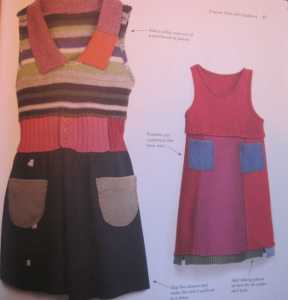Here is the scarf that made me think I could stitch a sweater out of old felted wool sweaters.

I must admit I have more than one of these. They really can add a nice touch to a boring winter assemble.
Isn’t it beautiful? I was reluctant to share this information as now everyone in Anchorage will have beautiful scarves just like me. Its kind of like the Skhoop. If it makes a good northern climate clothing statement, arctic fashionistas will buy it. Angela Eisman makes and designs them.
The rosettes are stitched by sewing machine. This made me think, why can’t I do that and make sweaters?
Crispina ffrench’s book The Sweater Chop Shop gave me the information I needed to learn how to felt old sweaters in the washing machine.

There is loads of good info in this book especially if you like to felt sweaters but don’t know what you want to do with them.
Crispina offers good advice about washing machine felting as well as many cute patterns. Her method involves taking old sweaters and felting them in the washing machine and then re-using the sweaters parts by hand stitching them together into new garments. You’ll find more about her work here. 

These sweaters are super fun, but not exactly what I wanted to do. I wanted very clean lines for my sweaters, and I wanted to machine stitch them.
I used Vogue pattern #8817 for my first try. I figured any pattern that could be made with a two-way stretch knit could be made with felted wool.

This pattern is designed by Katherine Tilton. It’s a great pattern with very flattering lines for a woman with curves. I made the short version. You can see it in the bottom right corner of the pattern cover.

Here is the back of the pattern where you can see the piece lines better. Those curved side pieces really slim your middle down.
And I was right. I was happy with my first results. The collar edge is not as crisp as I would like, but all in all it was a great first try.

If you look at the grey wool closely you will see a little pocket. I love doing this–taking elements of the original sweater and incorporating them into the new sweater.

I pieced the bottom of the front of the original sweater to the bottom edge of the back of the original sweater. This created a nice seam line in the middle of the new sweater back. I will write more about this in a future post.
Next I did a version of the same sweater in navy, black, and grey. For both sweaters, especially the navy version, I did a lot of piecing–TOO much piecing–of the felted sweaters to get pieces of wool big enough so that I could cut a pattern piece out of it.

I like the way I did the sleeves on this one–using the different colors to make the fabric big enough to piece is something I have done on all future sweaters.
You can piece a lot of scraps of the same fabric together when you are making a quilt–the repetition of the quilt block and the quilting lines mask this extra piecing and really create a situation where the eye does not notice what is going on.
It doesn’t work that way with a sweater. Those extra stitch lines draw attention to themselves and can even be unflattering if they land in certain places on the garment.

The seam lines on the bodice here are okay, but I really had to fuss to make sure that they were placed properly on the bodice. I realized if I was going to do this, I really need to cut pattern pieces–actually sub-divide the bodice pattern piece into several pattern pieces.
This all got me thinking about how to create good lines that work with the lines/seams of the sweater but also make maximum use of the material I am using. It is very different from working with yardage off the bolt. And it is where my quilt piecing skills become relevant to this endeavor.




Pingback: The Making of the Mod « Maria Shell
What is the sewing technique you used to sew the pieces together? Is it machine washable?
Thanks
Sarah- To piece these sweaters I used my walking foot, a sturdy polyester thread, and a healthy 1/2 inch seam allowance. I ironed all of the seams open and then top stitched them which seems to help with the bulk of working with felted wool. YES. They are machine washable which is one of the best things about these sweaters. I have one that I have worn at least once a week for three winters, and it still looks good! Thank you for stopping by.